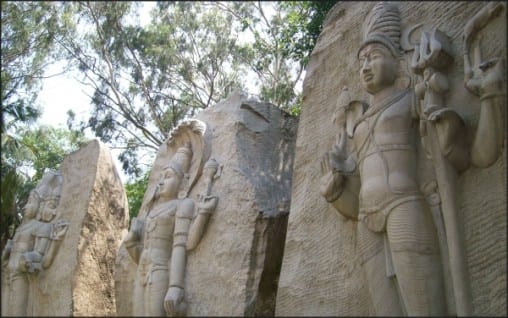Cross-Currents – Rural Cultural Practice and the Digital Economy in India and the UK
By Chris J Dillon, on 23 May 2014
Monday 12 – Wednesday 14 May at IIIT-B
The purpose of this workshop at the International Institute of Information Technology, Bangalore was to promote knowledge exchange between academics in the UK and India as well as with the IT industry in Bangalore, focusing on how digital technologies can be used to develop cultural, arts, heritage and relevant business practices at the community level in rural areas.
I’ve written short notes on each session below, with links to further information when available for those interested in the various areas. There was a very warm atmosphere.
Are you working on something similar and interested in adding an Indian dimension? Why not contact the people who gave the talks.
Day 1
The workshop was opened by Professor Debabrata Das, Dean Academics and R&D, IIT-B and Dr David Beel, University of Aberdeen.
Professor Alan Dix, University of Birmingham, spoke about Technology at the edge – connectivity issues in India, Wales and Tiree.
Rajeev Kuchhal spoke on Rural enterprises involving IT – connectivity and IT resource issues in India and Africa.
Dr Leanne Townsend, University of Aberdeen spoke about SIRA (Satellite Internet for Rural Access).
Broadband access can solve issues in rural areas, if it’s available. Broadband Delivery UK is attacking this problem and running pilot projects. SIRA is looking at satellite broadband, especially for the creative industries. She mentioned several case studies.
Dr Prithvi Raj spoke on the Digital Hampi (Heritage) Project.
I spoke to him and he agreed to put me in contact with people working on language at Hampi.
I gave a short presentation on Bridge to China.
Professor Navjyoti Singh spoke about Community Empowerment through Local Information Generalization and Utilization.
Dr David Beel and Dr Gemma Webster, Univ. of Aberdeen presented the CURIOS project about how digital archives can support local interest in local heritage and contribute to community regeneration and strengthened community cohesion. It has developed software tools to help remote rural communities collaboratively to maintain and present information about their cultural heritage. The objective is to investigate the use of semantic web / linked data technology to build a general, flexible and “future proof” software platform that could help such projects to come into existence and be sustainable over time.
T.B. Dinesh, Janastu spoke on Re-narration culture and the social Web. Janastu only uses open source software. Web pages recognise users and produce Web pages in another language. The Indian Digital Hampi website lists all the groups working on the project. It is likely that Dinesh will be visiting UCL in June.
Jonathan Sapsed, University of Brighton spoke about Superfusion – how arts and digital technology are combining to boost economic growth.
- The Brighton Fuse
- How the Creative-Digital-IT cluster is recasting economic value
- The intersection between STEM and A&H creates growth.
- They found that fusion is linked to growth – super fused companies grow three ties more- quickly.
- A&H is key to interdisciplinary interaction and innovation and economic growth.
Magda Tyzlik-Carver presented the University of the Village project via Skype.
Vijayanand and Lokesh Bhat spoke on the Use of digital technologies for a community cooperative initiative – history and field experiences.
Emile Devereux spoke about LawDigital: Digital cartography, participatory media, and the limits of legal discourse via video and Skype. This concerned simplifying legal language.
Helen Pritchard spoke on the Affectsphere of computational practices.
Day 2
This was a visit to Mysore, an old town about four hours away from Bangalore by bus. It has wide avenues and spacious buildings designed to be naturally cool.
Our first visit was to the Oriental Research Institute, followed by the Folklore Museum.
We had an Indian lunch at the Vishwa-Kshema Trust.
In 1996 a group of young men established an informal but active group to vivify the most enduring, ageless and immortal wisdom of Hindu lore and culture with a focus on the younger generation. Since then, Sanskrit awareness, Yoga and Meditation camps and social welfare activities including regular performance of Vedic rituals have been conducted in various parts of the country. These informal activities culminated in the year 2000 in the birth of “VISHVAKSHEMA”, a registered public charitable trust, with a clear idea of its objectives, philosophy and mission.
We made a visit to the MYRA School of Business where we were welcomed by Dr Shalini Urs, the Executive Director.
On the way home we made a visit to Mysore Palace to se a dispay of electric lights, unfortunately beyond the specification of my camera.
Day 3
Narasimhan M.G., Samskrti Foundaiton, Mysore spoke about An indigenous cryptographic system. The encryption works in a matrix.
M.A. Alwar spoke on A detailed bibliography of important manuscripts available on science and technology in ancient India. This included very useful website for practising Indian scripts – one of the best systems I’ve ever seen!
Nandini spoke on IT for Change – Exploring ICT possibilities for empowering marginalised women’s collectives.
I ran the “Languages and Scripts” research theme session.
ICANN is looking for experts for its Neo Brahmi Generation Panel.
There was a suggestion for a wiki based at UCL on Indian scripts for scholars and dealing initially with Sanskrit, with plans for Hindi and other Indian languages.
Amusing moment
Lack of rain caused hydroelectric problems in the Bangalore area and one became used to the power going off. The water supply is not affected at such times – as I discovered having a shower.
Further information: www.cross-currents.appspot.com and #XCurrents on Twitter.
 Close
Close


